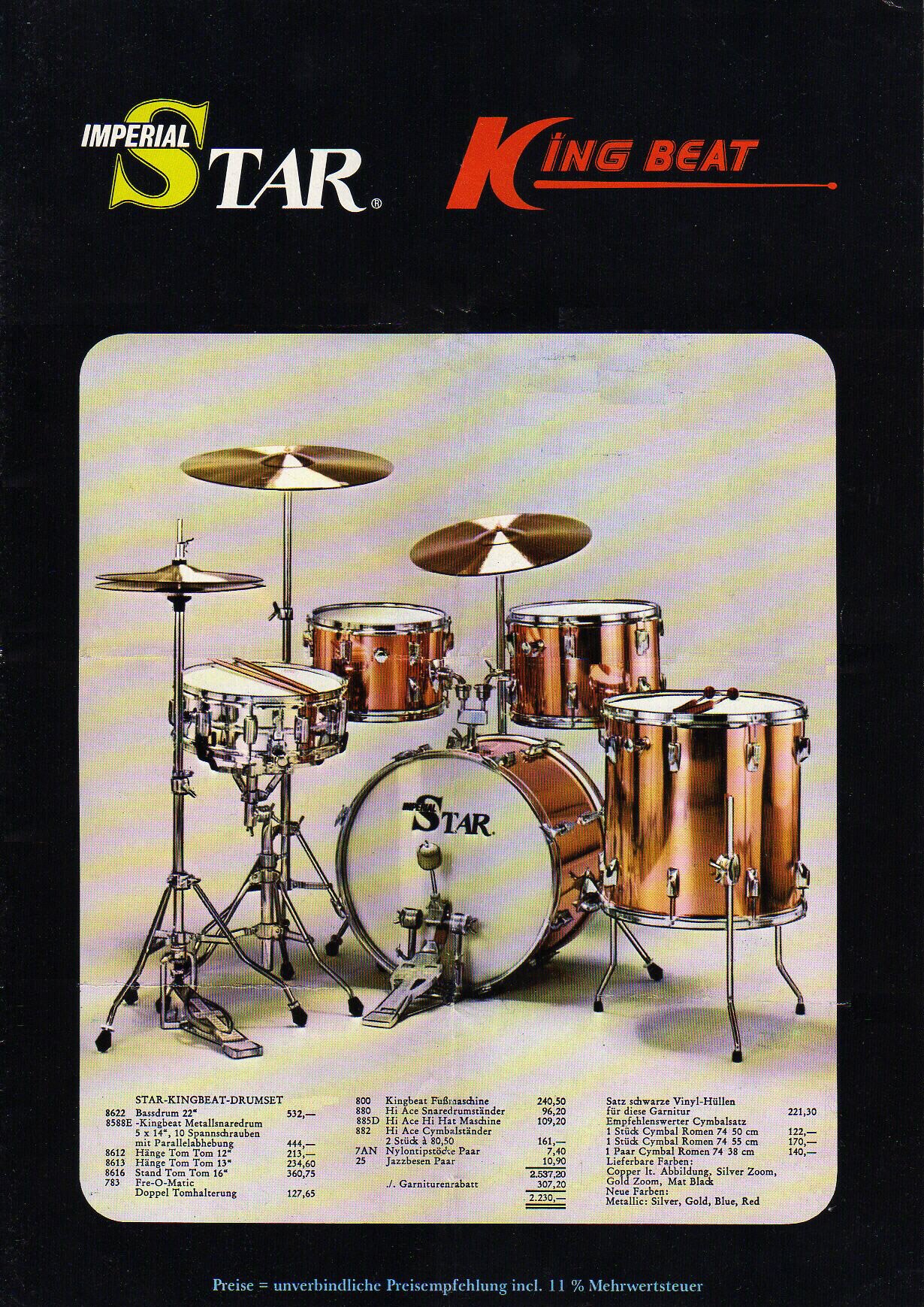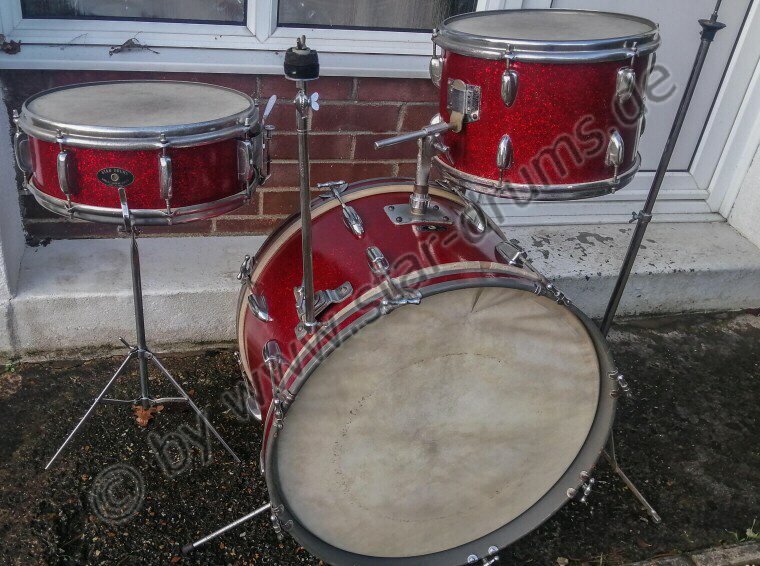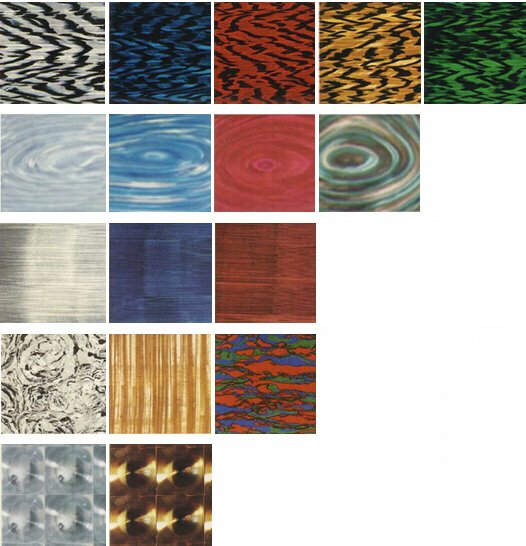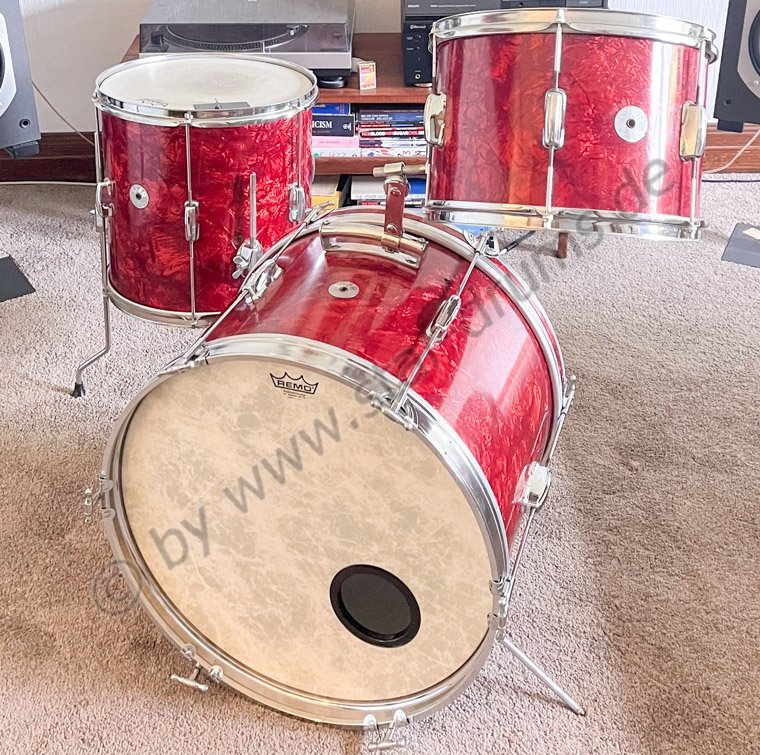Back in my school days, in the early 70s, my first drumming took place on a thrown together drum kit consisting of an old marching bass drum, two old marching snare drums (one of them used as a ‘rack tom‘) and a Pearl rack tom as a ‘floor tom‘ - plus a set of horrific metal plates you could hardly call cymbals. Fun to play as a starter kit, but soon the demands rose ...
So my first serious drum kit thereafter was a brand new Royal Star set in a shiny metallic Copper finish – a huge step forward. I still own it (... or should I say: own it back again - but that’s another story).
With this background I found some drummer forums in the early 2000s and joined discussions about old and ‘vintage‘ drums more and more. Around 2010 and, thanks to the Vintage Drum Forum (→ link:
www.vintagedrumforum.com), among the drum community many questions came up as to whether an old drum kit, that someone had found in the attic or as a bulky waste, was made either by Pearl or the other main Japanese company: Star. And it could be figured out in the discussions, that there were some tiny but significant differences between both. As I had a soft spot for Star drums due to my first real drum kit, I focused on learning and reading as much as I could about Star online. I collected information, leading me to start my own web site in 2013: www.star-drums.de, dedicating it to all those drummers, who like sharing a photo of their Star drum kits with all of us or who might have any questions about Star drums.
Throughout the ten years of my site, I have been in contact with almost 300 Star drums owners, worldwide. I can say that Star drum kits, still today, are really spread all over the world.
I hope to be able to maintain the contacts with some of these Star drum owners and I wish, as well, to get in contact with many other Star drum owners, who haven’t found their way to my web site so far, but hopefully will do in the future.
Now ... back to the history of Star drums:
Although the roots of Star go back to a time prior to WW II, serious production on a grand scale started first in Japan around 1965. Star did not settle on a fixed point. They made inventions and developed their product range, both in drums and hardware, in design, handling and useful additions over the years.
In the beginning the most important point was obviously to produce cheap drum kits, but over the years the focus changed to quality and the adding useful inventions, making Star drums unique, good sounding and sturdy. The Star King Beat snare drum is a good example, being introduced to the market in the last two years of Star: This 4.3 kgs heavy metal drum shell with its parallel action system was (and still is) a versatile snare drum with a cutting loudness, if necessary. But it has also sensitive characteristics while playing low volume parts. At least, it’s design was taken on by TAMA, so that this model remained unchanged (besides the update to the TAMA badge) for some further years.
Star bass drums were available in 20“ and 22“ – but I’ve never come across an 18“ bass drum as mentioned in the catalogues. Star rack toms had sizes in 12“ and 13“ (seldom 14“) and the floor toms in 14“ and 16“. An exception were the so called ‘Midget drum‘ kits, being small sized kits with a 16“ bass drum, 9“ rack tom and 10“ snare drum, intended, as the name suggests, for children.
The finishes covered the usual standard requirements of drummers with several ‘Sparkle‘ and ‘Marine Pearl‘ colours, but also included some interesting ‘Agate Pearl‘, ‘Satin Flame‘ and ‘Silky‘ wraps, as well as some special-effect wraps such as ‘Fantasia Pearl‘, ‘Fibre Gold‘‚ ‘Lava Pearl‘ and at least ‘Zoom‘ (available in Chrome or Gold): A finish consisting of small round mirrors in foil.
But Star drums didn’t appear solely under this name: There were an array of stencil brand names (so far from ‘Apollo‘ to ‘Werco‘) whose badges can be found on drum kits manufactured by Star.
The successor of Star from 1974 - TAMA - today still honours its roots by naming almost all their series with the word ‘Star‘ in it: Starclassic, Imperialstar, Stagestar, etc. etc..
And how did TAMA name their flagship model, the high-end kits made in Japan? ... ‘Star‘ ...!
So, finally, it comes full circle.
Today we know that Star also used to be sold under a number of other names since approx. 1965.
Due to the characteristic details of the drums this can be considered to be true. Namely the style of
the lugs but, tom brackets, shell constructions and the design of the badges are indicators for a drum kit,
telling us that it was made by Star (or not).
Besides Star’s brands, Bollero and DrumMate, the following brands of that time are believed to be made by Star as well
(I don’t claim that this list is already complete!):
Apollo (two versions) – Artist Ltd. – Barclay – BenTone – Boston – Carlton – Champion – Conqueror –
DrumCraft – Ibanez – Ideal – Jason – King’s Stone – Lido Supreme (two versions) – Lotus – Lucky Star –
Lyra (three versions) – Magnum – Majestic – Mayfair – Mitchel – Ralston – Revelle – Saturn – Stewart –
SupreMacy – Tempo – Tulio – U.S.Mercury – Weltron – Werco.
Typical is the wording ‘World’s Supreme Quality’ or ‘World’s Finest Quality’ on almost all badges from that time. And nearly all of these brands appeared in the USA only.
Latest entry: Badge Artist Ltd. .
Thanks for your attention!
Ralf





